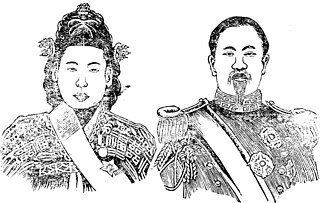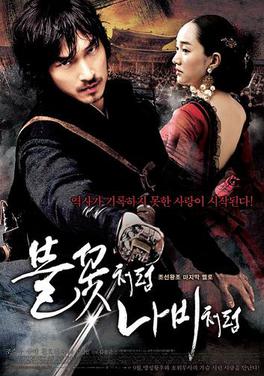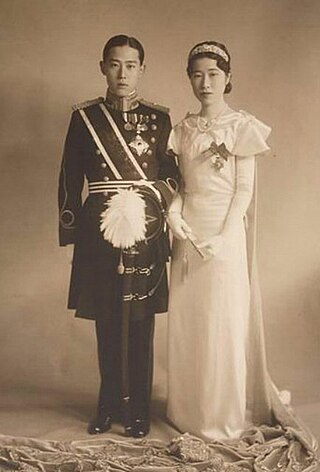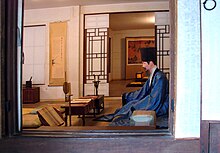
Gojong was the penultimate Korean monarch. He ruled Korea for 43 years, from 1864 to 1907, first as the last king of Joseon, and then as the first Emperor of the Korean Empire from 1897 until his forced abdication in 1907. He is also known as the Gwangmu Emperor, and was born Yi Myŏngbok (이명복). His wife, Queen Min, played an active role in politics until her assassination.

Sunjong, styled the Yunghui Emperor, was the last monarch of Korea. He ruled from 1907 to 1910 as the second and last Emperor of Korea. A member of the Yi dynasty, Sunjong was elevated to the throne after his predecessor and father, Gojong, was forced to abdicate by the Empire of Japan. Hence, Sunjong has been characterized by historians as being a powerless puppet ruler of the Japanese, reigning just over three years until Korea was officially annexed in 1910.

Empress Myeongseong was the official wife of Gojong, the 26th king of Joseon and the first emperor of the Korean Empire. During her lifetime, she was known by the name Queen Min. After the founding of the Korean Empire, she was posthumously given the title of Myeongseong, the Great Empress.

Deoksugung (Korean: 덕수궁) also known as Gyeongun-gung, Deoksugung Palace, or Deoksu Palace, is a walled compound of palaces in Seoul that was inhabited by members of Korea's royal family during the Joseon monarchy until the annexation of Korea by Japan in 1910. It is one of the "Five Grand Palaces" built by the kings of the Joseon dynasty and designated as a Historic Site. The buildings are of varying styles, including some of natural cryptomeria wood), painted wood, and stucco. Some buildings were built of stone to replicate western palatial structures.

Gyeongbokgung, also known as Gyeongbokgung Palace, was the main royal palace of the Joseon dynasty. Built in 1395, it is located in northern Seoul, South Korea. The largest of the Five Grand Palaces built by the Joseon dynasty, Gyeongbokgung served as the home of the royal family and the seat of government.
Yi Cheong is a member of the former Imperial Family of Korea and was a Korean-Japanese noble during Korea under Japanese rule in 1945–1947. He is a great-great-grandson of Heungseon Daewongun and the eldest son of Yi U and Park Chan-ju.

Heungseon Daewongun was the title of Yi Ha-eung, the regent of Joseon during the minority of Emperor Gojong in the 1860s. Until his death, he was a key political figure of late Joseon Korea. He was also called Daewongun, Guktaegong, or formally Internal King Heungseon Heonui, and also known to contemporary western diplomats as Prince Gung.

Hwangudan (Korean: 환구단) was a shrine complex that still partially stands in Jung District, Seoul, South Korea. The complex consisted of two main buildings: a coronation site and Hwanggungu. The coronation site was built in late 1897 and destroyed in 1913. Hwanggungu was built in 1899 and still stands today.

Empress Myeongseong is a 2001 and 2002 South Korean television series that aired on KBS2.

Yi Hae-won, also Lee Hae-won, was a member of House of Yi: the royal family of Joseon and the Korean Empire. She was born as the second daughter of Prince Imperial Ui who was the fifth son of Emperor Gojong of Korea. Her mother was one of Prince Ui's concubines, Lady Yi of Sudeok Hall. Yi was considered one of two pretenders to the throne, alongside her nephew, Yi Won.

Yi Junyong, known as Prince Yeongseon (영선군) was a politician, literati, and member of the Korean Joseon Dynasty's royal family, politicians, and later became a collaborator of Imperial Japan.

The Sword with No Name is a 2009 South Korean film based on a fictionalized account of Empress Myeongseong. The film sold 1,671,387 tickets nationwide.

Kim Hong-jip was a Korean politician best known for his role as prime minister during the Gabo Reform period from 1895–1896. His name was originally Kim Goeng-jip (김굉집) which he later changed to Kim Hong-jip. His father, Kim Yeong-jak, served as mayor of Kaesŏng in the Joseon Dynasty.
Queen Hyojeong of the Namyang Hong clan, was the second wife and queen consort of King Heonjong of Joseon, the 24th monarch of the Joseon Dynasty.
The Gaehwa Party, Gaehwapa or Gaehwadang was a liberal and progressive party in the Korean state Joseon. It was also called the Independence Party of Joseon, the Innovation Party of Joseon, and the Reformist Faction.

Park Chan-ju, was the spouse of Prince Yi U of Korea.

Jin Chae-seon was a Korean pansori singer, widely regarded as the first female master of a male dominated genre, although she was probably not the first woman to perform pansori, as gisaeng courtesans might have performed it before her. She was a master of performing Chunhyangga and Simcheongga.

The Yeoheung Min clan is a Korean clan that traces its origin to Yeoju, Gyeonggi Province. The 2015 Korean Census counted 167,124 members of the Yeoheung Min clan.
Prince Imperial Waneun was a prince of the Korean Empire and a member of the Joseon dynasty royal family. He was a descendant of Prince Namyeon and an illegitimate son of Heungseon Daewongun and his concubine Kyeseongwol. He was an older half-brother of Gojong of Korea and Prince Imperial Heung, and a half-uncle of Prince Youngsun and Emperor Sunjong of Korea. His personal name was Yi Jae-seon. His Chinese name is unknown.
Grand Internal Princess Consort Sunmok, known before as Grand Internal Princess Consort Yeoheung, was a Korean noblewoman who became a Joseon dynasty royal family member through her marriage with Internal Prince Heungseon, and was the biological mother of Emperor Gojong of Korea.

























